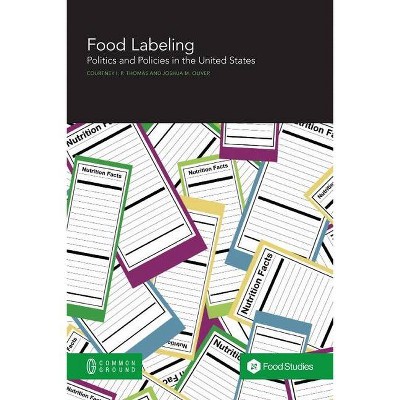Food Labeling - by Courtney I P Thomas & Joshua M Oliver (Paperback)

Similar Products
Products of same category from the store
AllProduct info
<p/><br></br><p><b> About the Book </b></p></br></br>Consumers rely on food labels for economic, ethical, and lifesaving information. This edited volume examines nutritional, organic, GMO, fair trade, cage free, and cultural food labeling practices. Each author's perspective emphasizes the importance of the food labeling policies that regulate this mechanism of communication in the marketplace.<p/><br></br><p><b> Book Synopsis </b></p></br></br><ol> <li> <ol> <li>Consumers rely on food labels for all kinds of economic, ethical, and lifesaving information. What are the ingredients in this product? Does it conform to kosher or halal standards? Is it organic or free of genetically modified ingredients? Has it been ethically produced and traded? However, as essential as this information is to consumers, many people find themselves overwhelmed, confused, or misinformed by food labeling practices.<br /> <br /> Authors examine the effectiveness of nutrition labels particularly for consumers with specific dietary needs and restrictions linked to health concerns. They analyze the history of the organic labeling movement and the future of this highly regulated and controversial term. They bring to life the legal battles that have emerged surrounding the labeling of genetically modified and bioengineered foods, and the interactions among federal agencies, state legislatures, Congress, and the judiciary. They scrutinize the future of fair trade certification, and the linkages among trade transparency, human rights, social justice, environmental sustainability, and economic security. Authors examine the use of cage free, free-range, and pasture raised designations for chicken and egg production. They discuss the Fair Food label claim and the importance of consumer support in the success of boycotts and buycotts. Finally, they illuminate the cultural and economic intersection of food labeling and Islamophobia, demonstrating the ways in which food labels can become central in nationalist discourse.<br /> <br /> Each author's perspective emphasizes the importance of the food labeling policies that regulate this essential mechanism of communication in the food marketplace.</li> </ol> </li> </ol><p/><br></br><p><b> Review Quotes </b></p></br></br><br><p>Table of Contents</p><p>Preface</p><p>Contributors</p><p>Chapter 1-Processing Nutrition Labels: Effects of Instructions, Health Conditions, and Label Length</p><p>by Michael D. Basil, Debra Z. Basil, Sameer Deshpande</p><p>Chapter 2-What's Organic? The Politics and Policy of the Practice and Label in the 21st Century</p><p>by Samantha L. Mosier</p><p>Chapter 3-The Competitive Politics of Labeling Genetically Modified Foods, Now Bioengineered Foods</p><p>by Gina L. Keel</p><p>Chapter 4-The Future of Fairtrade from Farm to Shelf</p><p>by Alissa Bilfield</p><p>Chapter 5-Chicken and Eggs: Cage Free, Free-Range and Pasture Raised</p><p>by Julia L. Lapp</p><p>Chapter 6-Labels: keys to the Success of Consumer Buycotts</p><p>by Jamille Palacios Rivera</p><p>Chapter 7-What the Halal? Islamaphobia and Food Labeling in the Post 9/11 U.S. Markets</p><p>Courtney I.P. Thomas</p><p> </p><br>
Price History
Price Archive shows prices from various stores, lets you see history and find the cheapest. There is no actual sale on the website. For all support, inquiry and suggestion messagescommunication@pricearchive.us




















